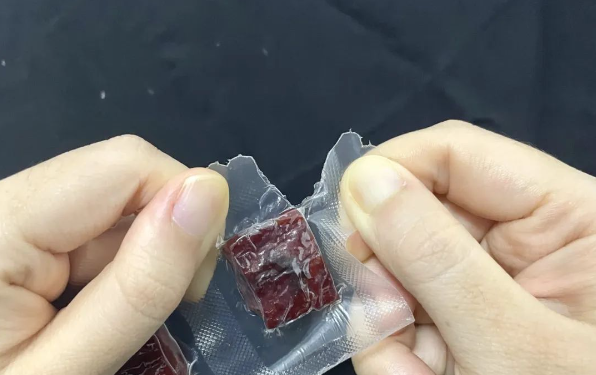The snack packaging has serrations and cannot be torn open. What’s going on?

Textured Vegetable Protein Industry News
2024年7月12日
Baichuan Biotechnology successfully held a seminar for the introduction of new products in the leisure sector.
2024年9月4日This article is original to Guokr, author: Chuangqiaoyu, editor: Luna. Please contact the source for reprinting.
Stubborn packaging will punish anyone who doesn’t have scissors at hand. It clearly says “tear along the serrations”, but the serrations are just for show. Not only can’t you tear it apart by hand, but even your teeth can’t make it yield.
What went wrong? Why can’t some packaging bags be torn apart even with serrations, while others can be torn apart easily without serrations?

- Is it always the braised eggs that can’t be torn apart?
The most common complaints about the packaging being difficult to tear are usually snacks such as sausages, braised eggs, and gluten. What they have in common is that they are vacuum packed. This packaging may be difficult to tear apart to ensure product quality.
Vacuum packaging removes air during packaging, which can make the oxygen content in the bag very low. When the oxygen content drops from 21% to 0.5%-1%, the reproduction of most aerobic bacteria and fungi will be inhibited. Therefore, vacuum packaging can play a role in preservation and freshness, greatly extending the shelf life of food.

To keep food fresh, vacuum bags must remain highly sealed for a long time. This requires the bags to meet two conditions at the same time: first, the material itself can prevent gas from passing through; second, the bag must be intact and not damaged.
During production and transportation, small cracks may appear on the surface of the bag. If the packaging material is too easy to tear, these small defects can easily expand and cause the package to break.
Any damage will destroy the seal, allowing oxygen to enter and causing the vacuum-packed food to spoil prematurely – this is a much more serious quality problem than the packaging being difficult to tear. Therefore, manufacturers always prioritize ensuring that the packaging bag is strong enough, even at the expense of easy tearing.
- Why can’t the package be torn open even with serrations?
The presence of serrations and cuts can help concentrate stress (force per unit area) to one point, making the package easier to tear. But even with this design, it still happens from time to time that the package cannot be torn open.
The package cannot be torn open for the following reasons:
If it cannot be torn open from the beginning, it may be that the easy-tear design is unreasonable, such as the serrations are too shallow.
More commonly, it can be torn open at the beginning, but it can no longer be torn halfway. This may be because the packaging uses a material with good tear resistance, such as linear low-density polyethylene. This type of material has good flexibility and ductility, and will deform greatly when torn and is difficult to crack.

Sometimes, the problem is the delamination of the bag. To achieve the best protection, bags are often made of multiple layers of different materials. If the materials are not tightly fitted, the bag will delaminate when it is stressed.
Sometimes, the problem lies in the direction of the tear. Ordinary packaging materials cannot control the tear direction, which sometimes results in a large tear that spills out, and sometimes only a corner of the package can be torn off, and it cannot be fully opened.

- How to improve?
The simplest way to improve tearability is to change the design of the tear opening, such as changing it from a sawtooth to a tear line across the packaging bag. This tear line is made by laser, which can cut the outer layer of the packaging material, greatly reducing the force required for tearing. At the same time, it can keep the inner layer of the material intact to avoid damaging the sealing of the packaging.

Some packaging bags do not have any tear-off edges, but can still be easily torn. In this case, the manufacturer has improved the performance of the material itself. By adjusting the production process, the molecular arrangement and crystallization state of the plastic film can be changed, and the tearing performance can be greatly changed without changing the chemical composition. This can also produce films with completely different transverse and longitudinal tear strengths, so that the tearing direction of the package can be controlled.
However, increased tearability also means that the firmness of the packaging bag will be somewhat reduced. In situations such as vacuum packaging that require high tear resistance, there is another solution: completely give up tearing and change the opening method to opening from the middle of the two films.

Good packaging should meet the requirements of “firm sealing” and “easy opening” at the same time, but these two requirements are contradictory, and it is not easy to find the best balance. I hope that more advanced easy-tear/easy-open technology can be popularized as soon as possible, so that we no longer need to rely on scissors and teeth when eating snacks.


